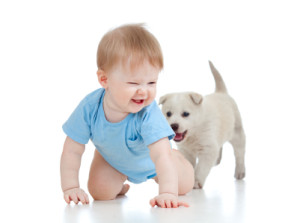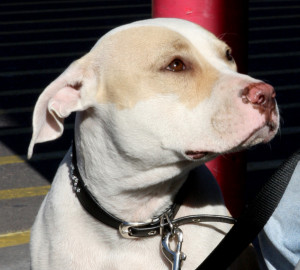How are Dogs Like Knives?

Great times or headed for trouble? (Or both?)
Dogs are “man’s best friend” for a reason – they’re naturally wonderful companions. But, they also have knife-sharp teeth, strong jaws, and they communicate with their mouths. With the automatic assumption that every dog is a “best friend”, we often get kids (and the dogs we love) in trouble. Would you let your kid play with knives unsupervised?
“Dog bites are the fifth highest reason why children seek emergency room treatment due to activities they voluntarily engage in…”1 You can make everyone around your dog safer by understanding a very important distinction – the difference between a dog tolerating attention versus enjoying it.
Most dogs deliver us a lifetime of tolerance. They are often great with kids, being gentle with their strong bodies and jaws, allowing all kinds of rough treatment. This makes us forget that dogs are not stuffed animals for unlimited cuddling (much as some of us hate to admit it). Remember, the upside of a good interaction is a wagging tail and a smiling child, but the downside of a bad interaction is a bite that scars a child’s face (and mind), plus a dog that may need to be removed from the family. This is why kids and dogs together must be taken seriously. There are 3 basic things that all dog owners, trainers, and parents can remember to increase the safety of interactions between dogs and children.
1. Everyone has their limits.
Be aware that no matter how wonderful your dog is, there is always a limit to how much she can take. A dog who growls at a toddler for pulling her ear for the hundredth time this week is probably not a bad dog overall. But, we’ve reached the (very high) limit that she’s been pushed to, and we need to intercede to prevent things from escalating to a bite. Don’t find your dog’s limits. Intervene before the limit is reached.
2. Look for signs of stress.

Is this dog eager to be approached? (Answer at end of article)
Dogs CAN have a bad day. Humans have temper tantrums when they’re stressed, cats scratch when pushed, and if you’ve ever been on a horse, you know that you have to sign a release first because horses can break your bones with one frightened toss of their head. Dogs aren’t happy-go-lucky in all situations either. Bad days will happen when a lot of stress piles on at once. Signs of stress include turning away, crouching, yawning, lip-licking, shaking-off, panting, ears back, hiding and more. Don’t ignore these signs, especially when kids are interacting with your dog.
3. Intervene early
If you think a dog may be stressed in an interaction with a child, intervene now. Not sure? Don’t risk it. A simple test you can try is to remove the child from the situation and then see if the dog comes back to the child for more attention. This will tell you if the dog was enjoying the interaction (comes back for more), or just tolerating it (stays away, or leaves the scene). If the dog was just tolerating it, give her a break for everyone’s sake.
The Wrap:
When we’re smart about it, kids and dogs can be best friends. There are plenty of dogs who will actively seek out children to play with. They’re a thrill to watch together. But, not all dogs fit that mold. “She loves kids,” is often used to describe a tolerant dog who is being chased around the house with a toddler grabbing her tail like a water skier. When we take a moment to look at this situation closely, we can see that the dog is stressed and trying to avoid conflict. If we don’t help the dog right then, a bite is her only way out.
It’s our job to parent – the dogs and the kids. So remember: every dog has their limits, look for signs of stress, and intervene early. All members of your family will be happier and healthier for it.
Answer to the photo caption above: The pit mix looks stressed (ears back and down, mouth closed and tense, “eyebrows” up in a worried expression). She is not inviting an interaction with the person approaching (her head is turned away from camera and she is looking up to her owner for support). A dog inviting an interaction would be turned towards the person approaching, and have a relaxed face, likely with an open mouth and ears in a more neutral or forward position.
Learn more about how you can become skilled at reading dog body language.






 Phone:
Phone:
I agree dog looked stressed, ears were back. We as dog owners need to pay attention when children are around, myself I never let my kids or anyone else’s kids pull on my dogs ears or tail.
Hi I have a puppy and shes recently started barking at my 2 and 1 year old. Mostly the 2 year old. Even when she is just sitting on the couch. She has annoyed the puppy in the past to which I intervene and tell her she can not do that to the puppy. When shes ignoring the puppy, the puppy will go up to her and will follow her as if she is curious what she is doing. Her ears are floppy and her tail is waggling slightly it’s kind of up high. I don’t know what this means. I’m trying to find out on Google but cant seem to find help
Hi Karra, This sounds like a situation where you could really use a professional trainer to assess what is happening and help guide you. Here are some of our favorite recommended trainer directories:
https://catchdogtrainers.com/trainers/
https://apps.apdt.com/eweb/DynamicPage.aspx?webcode=TrainerSearch
https://www.ccpdt.org/dog-owners/certified-dog-trainer-directory/
https://m.iaabc.org/consultant/